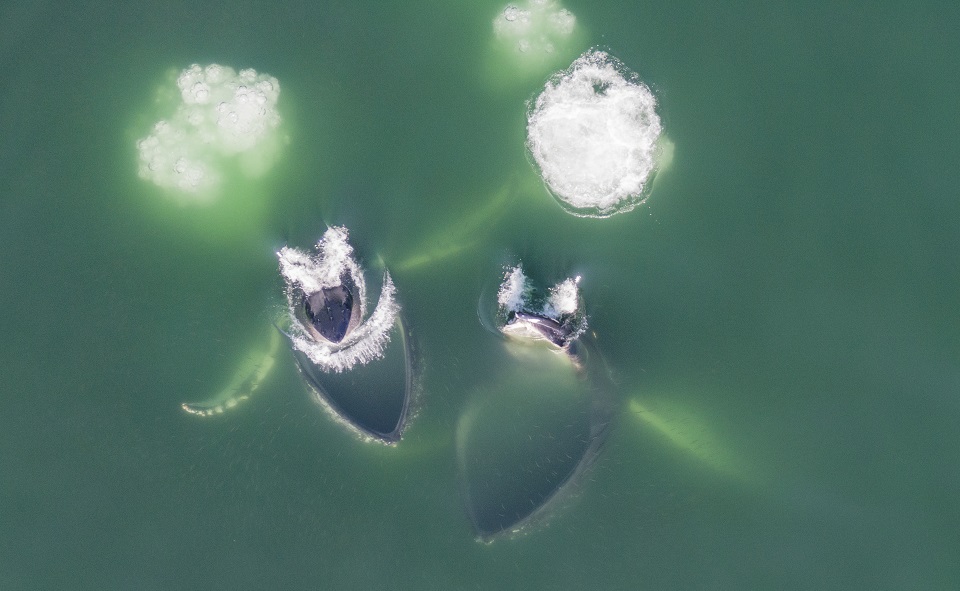Whales, from above

Sutton Lynch rises most days before the sun, arriving at Atlantic Beach in Amagansett, New York, for the early-morning calm. It’s the same beach he’s been going to since he was a child, and where he worked as a lifeguard for years as a teenager. Now 23, he spends his mornings surveying the horizon. When he spots activity on the water’s surface, he sends out his drone.
Lynch has earned a devoted following on Instagram for his remarkable footage of marine life off the coast of the East End of Long Island. Alongside images and videos of humpbacks, hammerheads, dolphins, bluefish and many other species, he writes captions that range from childhood memories and research on the effects of fishing policy to explanations of animal behavior. Across the board, his work exudes a reverence for the ocean and the creatures that call it home.
Lynch’s followers often express surprise that this abundance of species exists just out of sight. The truth is, the resurgence is fairly new. And so the photographer is documenting a dramatic turning point in the East End’s environmental and cultural history — a renewal of sea life after decades of depletion.
As recently as 10 years ago, a whale or dolphin sighting was an uncommon occurrence on the East End. The overfishing of Atlantic menhaden — a keystone species that is essential to a healthy ecosystem — led to a huge drop in marine life off the coast of Long Island in the latter part of the 20th century. (Bony and oily, menhaden are harvested for their nutrient-rich oil and are rarely eaten by humans; they feed on plankton and algae and serve as prey to dozens of larger animals.)
In 2012, in response to menhaden’s numbers having fallen about 90% in three decades, the Atlantic States Marine Fisheries Commission enacted the first coastwide catch limits on the fish. Populations soon rebounded, improving water quality and bringing more whales, sharks, rays, seals, dolphins and other animals closer to the beach than they’ve been since the middle of the last century.
“It’s very rare that you have a conservation gain that is so visible in such a short time,” said John Gans, a northeast field representative for the Theodore Roosevelt Conservation Partnership. “And it’s 100% attributed to the 2012 catch limits put in place on menhaden.”
The return of larger animals that feed on menhaden coincided with Lynch’s coming-of-age as a photographer. He got his first drone at 17 and began filming from his home shores.
It’s fitting that his career would hinge on a humble fish. In a region, the Hamptons, and on a platform, Instagram, known for exclusivity and superficiality, Lynch’s work is both accessible and authentic. “There’s nothing pretentious about him,” said Victoria Cooper, an Amagansett resident and a professed superfan, while visiting one of his photography sales this summer. “You can get caught up in being out here; there’s lots of parties and things. I love that Sutton is taking a deeper look behind the scenes of the nature that we’re all part of.”
Long Island is particularly vulnerable to global warming, owing to its susceptibility to sea-level rise, the increasing frequency and intensity of storms, and the growing incidence of algal blooms, among other phenomena. (The region recently appeared near the top of a list by Moody’s Analytics of U.S. metro areas that will be worst hit by climate change.)
Lynch is partly motivated by documenting those changes. Some complex combination of frustration and conviction characterizes his — and much of Gen Z’s — attitude. “It’s hard for older generations to understand how we feel,” he said. “My parents’ generation often says, ‘You guys are going to fix this,’” he continued. “But they’re the ones in control, and everything needs to be done now.”
But he also sees his art as a kind of longitudinal study of a seascape — a way to track the subtler, and in his view more insidious, changes that happen over years, increments that add up to a transformed ecosystem. If his practice continues for a decade, he said, he’ll have compiled a sizable portfolio of visual information. “Ideally I would love to work with scientists who could study that data,” he said.
Lynch’s fan base includes not just environmentalists but also artists and fishermen, locals and out-of-towners. “Nobody likes being told what to think,” Lynch reflected, when asked how he approached the educational aspect of his work. “I don’t want to alienate any of my followers. I just want to give them the facts.” Wary of scare tactics or blame, he chooses instead to appeal to people’s shared admiration for their landscape. “Fear is not helpful, in my opinion,” he said.
And while the recent uptick in shark activity may be cause for concern among beachgoers trying to enjoy a Hamptons getaway, to Lynch it’s a thrill. In July, after filming spinner sharks, he wrote: “They’re wild animals, and the ocean is their home. They certainly can be frightening, but it’s important to remember that humans pose a much greater threat to them than they do to us.” A great white sighting is at the top of his bucket list. And the East Hampton lifeguards who count on his shark patrol — the city pays him hourly to look for the animals while he’s perusing the coast with his drone — will certainly be grateful for the report if he ever spots one.
Arthur Kopelman, an ecologist and the president of the Coastal Research and Education Society of Long Island, reflected on the value of public environmental education. “It’s critically important,” Kopelman said, adding that knowledge about their surroundings helps people “become active stakeholders in terms of protecting their coastal ecosystems.” Lynch is part of that effort, bringing us close to the action and urging his followers to share in his admiration for nature.
Against a backdrop of the stereotypical opulence and excess of the Hamptons, Lynch’s work is a refreshing reminder of why the New York elite started visiting these now-iconic shores in the first place. Celebrities, tycoons and tenacious weekenders aren’t the only ones flocking to the endless miles of sandy beaches and rolling dunes — a growing society of sea life makes its home here, too, just offshore.
This article originally appeared in The New York Times.






